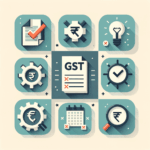Tips for Reconciling Invoices with GST Returns
For many Indian small business owners, the end of the month brings a familiar challenge: a growing pile of invoices and the daunting task of matching them with GST returns. The fear of making a mistake, missing out on valuable tax credits, or receiving a dreaded notice from the tax department is very real. This is where our expert reconciling invoices tips come in. In simple terms, GST invoice reconciliation is the critical process of matching the data from your sales and purchase records with the details filed in your GSTR-1 and the data automatically populated in your GSTR-2B. This isn’t just an administrative chore; it’s a non-negotiable financial practice that directly impacts your bottom line. Proper GST return reconciliation guidance helps you maximize your Input Tax Credit (ITC), avoid costly penalties, and maintain a high GST compliance rating, ensuring your business stays financially healthy and legally sound.
Why is Accurate Invoice Reconciliation Crucial for Your Business?
Before diving into the “how-to,” it’s essential to understand why this process is so critical. In the complex world of GST, meticulous reconciliation is not just about ticking boxes; it’s a strategic activity that protects your cash flow and legal standing. Ignoring this process can lead to significant financial leakage and unnecessary regulatory scrutiny. Making effective invoice reconciliation in India a core part of your monthly financial operations is one of the smartest decisions you can make for your business’s long-term health and stability.
To Maximize Your Input Tax Credit (ITC)
The single most important reason for diligent reconciliation is to maximize your eligible Input Tax Credit (ITC). Under the current GST regime, you can only claim ITC on invoices that are correctly reported by your suppliers and subsequently appear in your GSTR-2B. If an invoice from your supplier is missing from this statement, or if the details are incorrect, you simply cannot claim the credit for the GST you have already paid on that purchase. Without a systematic process of matching every purchase invoice against your GSTR-2B, you risk leaving money on the table. This unclaimed ITC is a direct hit to your working capital and profitability, essentially increasing your costs and reducing your cash flow.
To Avoid GST Notices and Penalties
The GST Network (GSTN) is a sophisticated system designed to track transactions and detect discrepancies. Any mismatch between the sales you declare in GSTR-1, the ITC you claim in GSTR-3B, and the data available in your GSTR-2B acts as a red flag for tax authorities. Such discrepancies can automatically trigger scrutiny, leading to notices demanding clarification or, worse, penalties. If you claim ITC for an invoice that your supplier failed to report, the department may demand that you reverse the credit along with substantial interest and penalties. Regular reconciliation ensures your records are aligned with the GST portal, significantly reducing the risk of such unwelcome attention from the tax office.
To Ensure Accurate and Timely GST Return Filing
A smooth and error-free GST filing process is built on a foundation of clean, accurate, and reconciled data. When you reconcile your accounts on a monthly basis, you identify and resolve issues as they arise, rather than letting them accumulate. This proactive approach prevents the last-minute chaos that often occurs near filing deadlines, which is a common source of errors. Effective invoice reconciliation in India means that when it’s time to file your GSTR-3B, you have a verified and accurate ITC figure ready to go. This not only ensures compliance but also instills confidence in your financial reporting and saves countless hours of stressful rework.
A Practical Guide: How to Reconcile Invoices with GST Returns
Now that the importance is clear, let’s walk through the step-by-step invoice reconciliation process in India. This practical guide breaks down the complex task into manageable steps, providing a clear roadmap for any business owner. Following this structured approach is key to understanding how to reconcile invoices with GST returns efficiently.
Step 1: Gather All Necessary Documents
The first step in any reconciliation process is to collect all the relevant data. Having everything in one place before you begin will make the entire process smoother and more organized. A clear understanding of the core document is crucial; you can find more details in our guide on Understanding GST Invoicing: A Detailed Guide. You will need:
- Your Sales Register: A complete record of all sales invoices you issued during the tax period.
- Your Purchase Register: A comprehensive list of all purchase invoices you received from your vendors.
- Filed GSTR-1 Data: This can be downloaded directly from the GST Portal. It contains the details of all the outward supplies you have declared.
- Auto-drafted GSTR-2B: This is also available on the GST Portal. It is a static statement that lists the ITC available to you based on your suppliers’ GSTR-1 filings.
- Filed GSTR-3B: Your summary return for the period, which shows the final tax liability paid and ITC claimed.
Step 2: Compare Your Sales Data with GSTR-1
This step involves verifying that you have correctly reported all your sales. You need to meticulously match every single invoice from your internal sales register against the data you have uploaded in your GSTR-1 on the GST Portal. During this comparison, pay close attention to potential discrepancies such as:
- Missing Invoices: An invoice present in your books but missing from GSTR-1.
- Incorrect GSTINs: The recipient’s GSTIN is wrongly entered.
- Wrong Invoice Values: The taxable value or total invoice amount does not match.
- Incorrect Tax Rates: The wrong GST rate (e.g., 12% instead of 18%) has been applied.
Any errors found here must be corrected in the next month’s GSTR-1 filing through amendments.
Step 3: Reconcile Purchase Data with GSTR-2B
This is the most critical part of the reconciliation process, as it directly determines your ITC claim. Your GSTR-2B is the official, non-editable document from the GST portal that reflects the ITC available to you for a given month. You must compare each invoice listed in your purchase register with the corresponding entry in your GSTR-2B. This comparison confirms whether your suppliers have filed their returns correctly and on time, making you eligible to claim the credit.
Step 4: Identify and Resolve Discrepancies
During the purchase reconciliation, you will likely encounter mismatches. It is crucial to identify, categorize, and act on these discrepancies immediately. Common issues include:
- Supplier Has Not Uploaded the Invoice: The invoice exists in your records, but is completely missing from GSTR-2B.
- Incorrect Details: The invoice number, date, or value reported by the supplier does not match your records.
- Invoice Uploaded to the Wrong GSTIN: The supplier made a typo in your GSTIN.
- Tax Amount Mismatch: The breakdown of CGST, SGST, or IGST is incorrect.
Actionable Advice: Once you identify a discrepancy, the only solution is to communicate with your supplier. Contact them immediately, provide clear details of the error, and request them to correct it in their next GSTR-1 filing. Until they make this correction, you cannot claim the ITC for that invoice.
Step 5: Finalize ITC and File GSTR-3B
After you have completed the reconciliation and have a clear list of all eligible invoices reflected in your GSTR-2B, you can determine your final ITC amount for the month. This reconciled figure is the amount you should claim in your GSTR-3B summary return. Filing your GSTR-3B based on reconciled data ensures accuracy, compliance, and maximizes your legitimate credit claims. For a full walkthrough of this final step, see our How to File GST Returns Online: A Step-by-Step Guide of the GST Filing Process & Procedure.
Top 5 Actionable Reconciling Invoices Tips
Mastering the reconciliation process requires more than just following steps; it requires implementing smart habits and leveraging the right tools. Here are our top five actionable reconciling invoices tips to enhance your efficiency and accuracy.
Tip 1: Maintain Meticulous and Digitized Records
The foundation of seamless reconciliation is impeccable bookkeeping, which involves Maintaining Accurate Accounting Records for Tax Purposes. Manual record-keeping is prone to errors that can snowball into significant compliance issues. It is highly advisable to use modern accounting software like Tally, Zoho Books, or QuickBooks. These tools not only minimize data entry errors but also structure your data in a way that makes reconciliation easier. For every single transaction, ensure you are capturing the correct supplier GSTIN, invoice date, HSN/SAC code, and taxable value. Adopting these digital invoice management strategies India is the first step towards a stress-free reconciliation process.
Tip 2: Reconcile Periodically, Not Annually
One of the biggest mistakes businesses make is waiting until the end of the year to reconcile their GST data. This creates a monumental task that is both overwhelming and ineffective. The best practice is to adopt a monthly reconciliation cycle. The GSTR-2B for a month is typically generated on the 14th of the following month. Schedule time right after this to perform your reconciliation. A monthly cycle makes the task manageable, allowing you to deal with a smaller dataset. More importantly, it enables you to identify and communicate discrepancies to your vendors much faster, increasing the chances of a swift resolution.
Tip 3: Leverage Automation Tools
Manually matching hundreds or thousands of invoices every month is not a productive use of your time. This is where technology can be a game-changer. Many modern accounting platforms have built-in reconciliation features. There are also specialized reconciliation tools available that can automatically fetch data from the GST Portal and match it against your purchase register in minutes. These tools can highlight mismatches, categorize errors, and generate reports, saving you countless hours of manual effort and reducing the risk of human error. Investing in automation is a smart investment in your business’s efficiency and compliance.
Tip 4: Establish Clear Communication with Vendors
Your ability to claim ITC is directly dependent on your vendors’ compliance. Therefore, establishing a clear and professional communication process is crucial. When you find a discrepancy, don’t delay. Reach out to your supplier with a clear, concise email detailing the issue. Here is a simple template you can use:
Subject: Action Required: Invoice Correction for GST Filing – [Your Company Name]
Dear [Supplier Name/Accounts Team],
We hope you are well.
While reconciling our purchases for the month of [Month, Year], we found that your invoice [Invoice Number] dated [Invoice Date] is not appearing in our GSTR-2B.
To ensure we can claim the Input Tax Credit, could you please upload this invoice in your upcoming GSTR-1 filing?
Thank you for your prompt attention to this matter.
Best regards,
[Your Name]
[Your Company Name]
Proactive communication is one of the most effective invoice accuracy tips India that fosters good vendor relationships and ensures your ITC is not delayed.
Tip 5: Understand the Key GST Forms
To reconcile effectively, you need to understand the role each GST form plays in the process. Confusing their purpose can lead to significant errors. Here is a simple breakdown:
- GSTR-1: This is your report card. It’s the return where you declare all your outward supplies (sales) for the month. The accuracy of your GSTR-1 impacts your customer’s ability to claim ITC.
- GSTR-2B: This is your eligibility statement. It’s a static, auto-generated statement from the GST portal that shows the ITC available to you for a specific month based on the GSTR-1 filed by all your suppliers. This is the definitive document for claiming ITC.
- GSTR-3B: This is your summary and payment form. It’s a monthly summary return where you declare your total sales, total purchases, final tax liability, and claim the eligible ITC as reflected in your GSTR-2B.
For the most current and official guidelines on these forms, always refer to the official GST Portal.
Conclusion
In conclusion, regular and meticulous invoice reconciliation is not just a regulatory requirement; it is a fundamental pillar of good financial management for any business operating under the GST regime. It is the key to unlocking your full Input Tax Credit, safeguarding your business from notices and penalties, and maintaining healthy cash flow. By adopting the best reconciling invoices tips—maintaining digital records, reconciling monthly, using automation, and communicating effectively with vendors—you can transform this complex task into a streamlined business process. Consistency and leveraging technology are your greatest allies in achieving compliance excellence.
Feeling overwhelmed by the invoice and GST return tips India? Let the experts at TaxRobo handle your GST reconciliation and filing with precision. Focus on your business, and we’ll ensure your compliance is flawless. Contact Us Today for a Free Consultation!
Frequently Asked Questions (FAQs)
Q1. What is the main difference between GSTR-2A and GSTR-2B?
A: GSTR-2A is a dynamic, real-time statement that updates whenever a supplier files or amends their GSTR-1. GSTR-2B, on the other hand, is a static, auto-drafted ITC statement for a specific month. It is generated on the 14th of the following month and cannot be changed. For the purpose of claiming ITC in your GSTR-3B, GSTR-2B is the official and binding reference document.
Q2. What should I do if a supplier’s invoice is not in my GSTR-2B?
A: You should immediately contact the supplier, inform them of the omission, and request them to upload the invoice details correctly in their GSTR-1 for a subsequent period. You cannot claim ITC on that invoice until it appears in one of your future GSTR-2B statements.
Q3. How often should I perform GST invoice reconciliation?
A: The universally recommended best practice is to perform reconciliation on a monthly basis. This should be done as soon as the GSTR-2B for the previous month is generated. Monthly reconciliation makes the task manageable and allows you to identify and fix errors promptly before filing your GSTR-3B.
Q4. Can I claim provisional ITC for an invoice not showing in GSTR-2B?
A: No. As per the current GST rules, the provision to claim provisional ITC (previously allowed under Rule 36(4)) has been removed. You can only claim ITC that is fully reflected and available in your GSTR-2B for that tax period.
Q5. What are the most common errors to check for during reconciliation?
A: The most common errors to look for are mismatches in the invoice number, invoice date, GSTIN of the supplier or recipient, taxable value, and the tax amounts (CGST, SGST, IGST). Additionally, you should always be vigilant for duplicate invoices reported by a supplier or entered in your own books.



